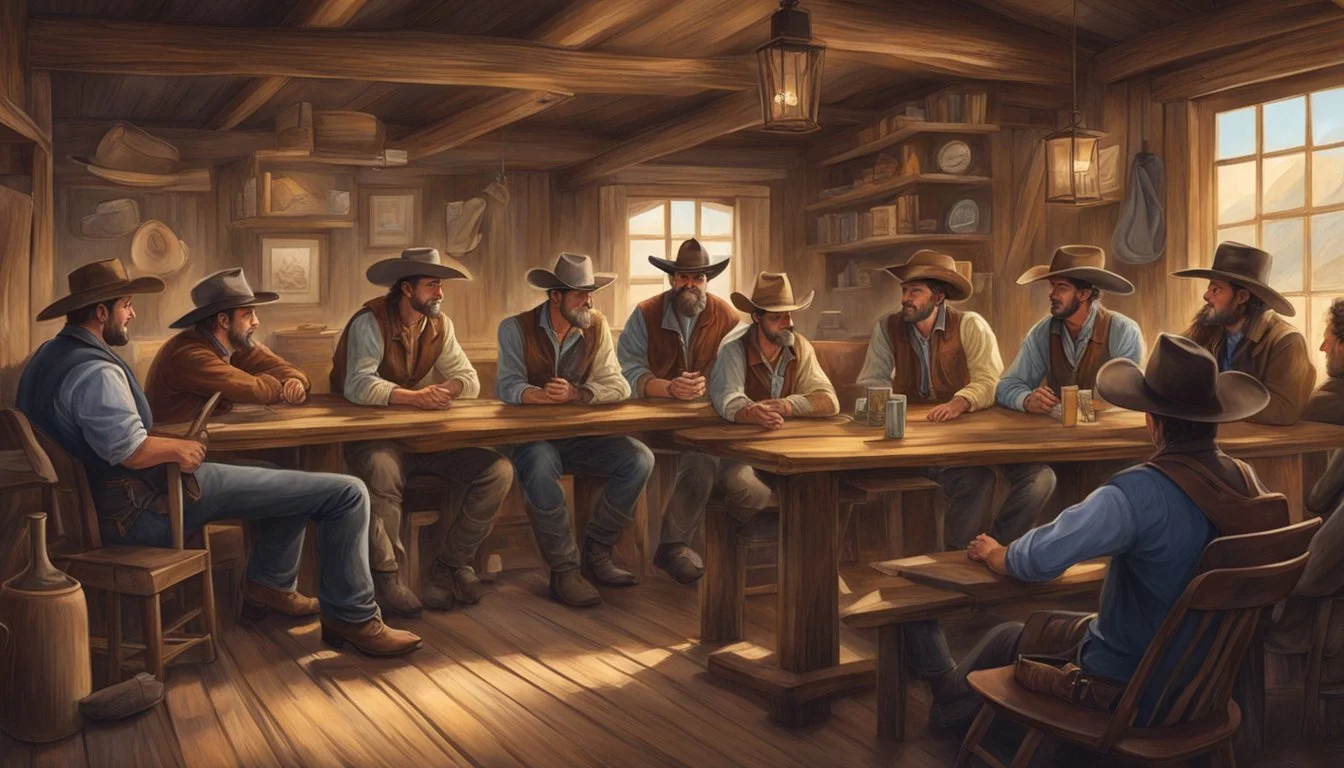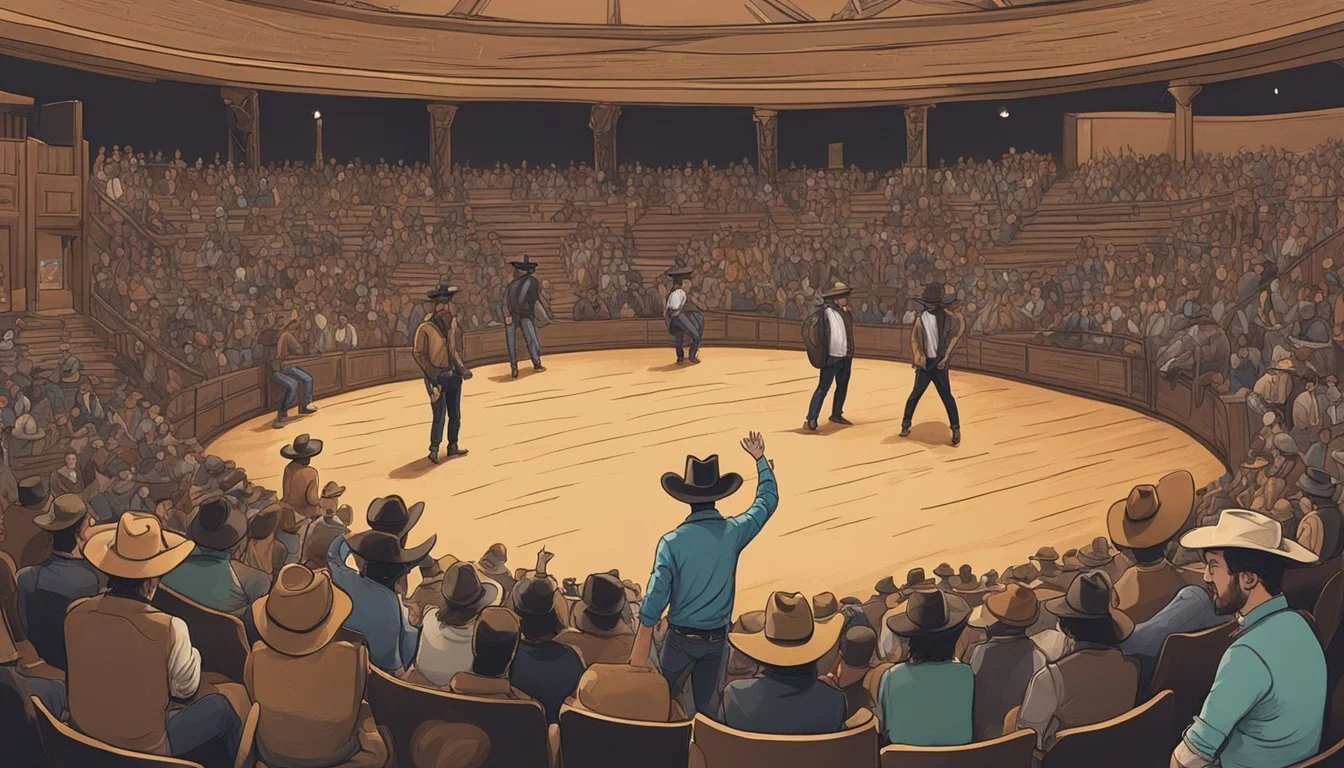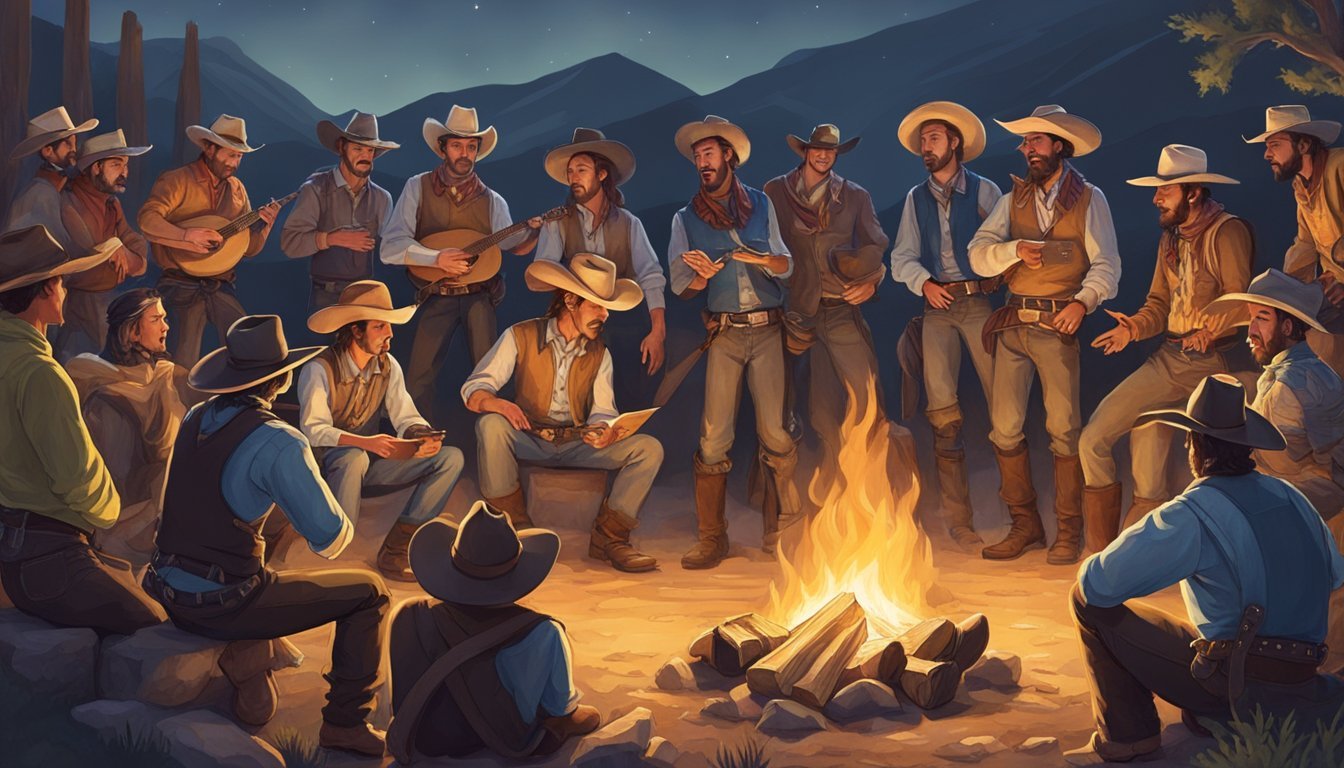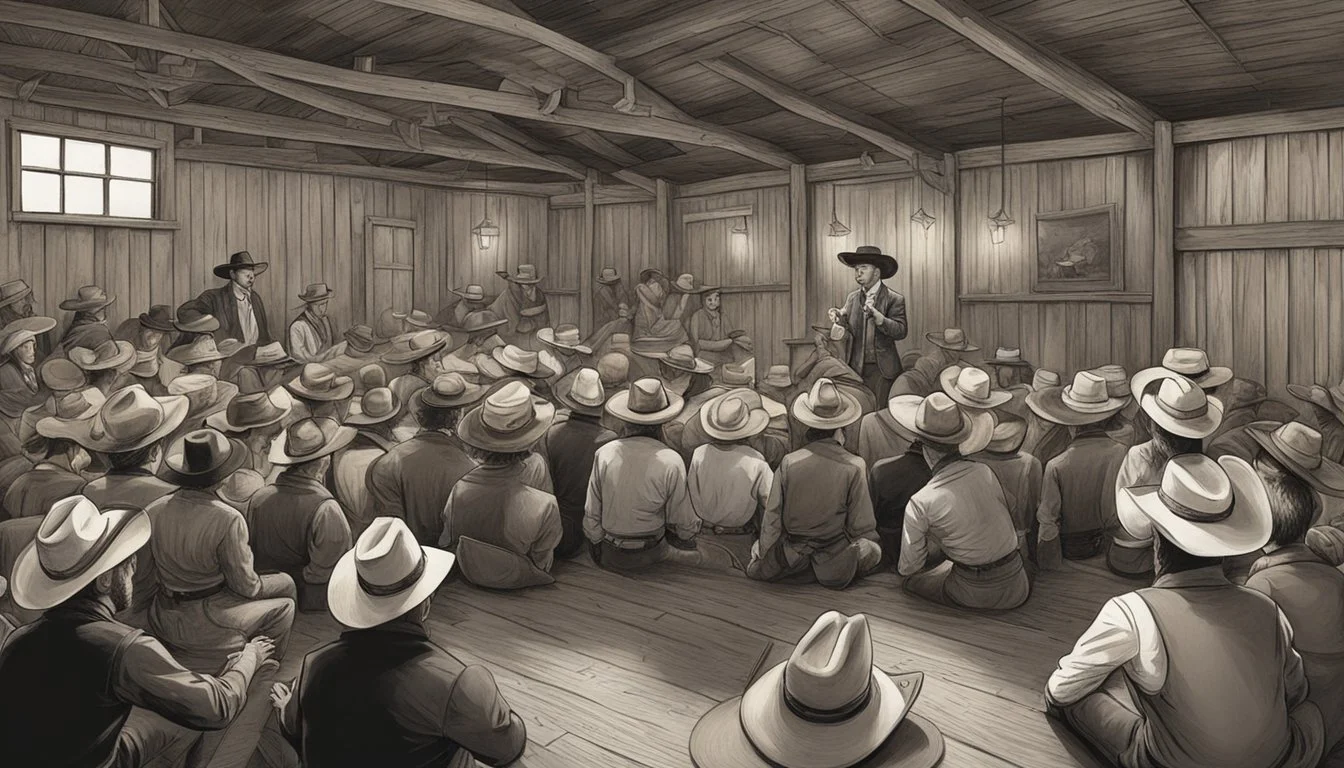The Rise of Cowboy Poetry Slams and Competitions
Unbridling the Spirit of the West
Cowboy poetry, an art form steeped in the rich heritage of the American West, has long since transcended its origins to become a vibrant aspect of contemporary performance art. Rooted in the late 19th century, it reflects the lives and experiences of cowboys, resonating with the rhythms of cattle drives and wide-open spaces. This expressive medium has found new life in modern times through the rise of poetry slams and competitions, where poets and audiences alike congregate to celebrate the enduring tradition.
Poetry slams, competitive events where poets perform their work and are judged on delivery and content, have become an inclusive stage for cowboy poets to showcase their talents. These gatherings serve as a junction where the oral tradition of storytelling meets the competitive spirit, keeping the cowboy poetry scene both lively and relevant. The performances often exude a sense of community and cultural continuity, linking the past with the present through verse and voice.
Cowboy poetry competitions provide a platform for this unique form of storytelling to thrive, offering poets the opportunity to engage with new audiences. The competitive aspect lends the art form an edge, pushing cowboy poets to hone their craft. At these events, the intricate interplay of history, culture, and personal narrative comes to life, ensuring that this distinctive voice of the American experience continues to be heard and appreciated.
Historical Evolution of Cowboy Poetry Slams
Exploring the dynamic progression of cowboy poetry slams requires delving into the confluence of slam poetry's raw energy with the storied traditions of cowboy poetry. This exploration chronicles the convergence of improvised spoken word with the pastoral reflections of cowboy life, charting its journey from intimate cowboy gatherings to the international stage.
Origins of Slam Poetry
Slam poetry originated in Chicago in the 1980s, fostered by construction worker and poet Marc Smith. It was designed as a competitive format that brought poets to perform their original work and be judged by an audience. The movement was a seismic shift in the poetry world, democratizing and energizing the art form.
Cowboy Poetry and Its Emergence
Cowboy poetry itself has a longstanding tradition in American culture, with its roots tracing back to the cattle drives post-Civil War. Central themes included livestock, the Western U.S. landscapes, and the essence of cowboy life. Cowboy poetry slams grew out of the fusion between the competitive nature of slam poetry scenes, such as those at the Nuyorican Poets Café spearheaded by innovators like Bob Holman, and the traditional storytelling and thematic focus of cowboy poetry.
Growth and Spread Worldwide
The cowboy poetry slam phenomenon extended beyond the United States, finding footholds in Europe, Canada, and even Japan. Here's a brief look at how slams have grown in different regions:
United States: The National Cowboy Poetry Gathering in Elko, Nevada, became a pivotal event for poets to perform in a slam-like environment.
Canada: Cowboy poetry competitions and recitations became a staple at festivals celebrating western heritage.
Europe & Japan: The appeal of the cowboy lifestyle and poetic tradition sparked interest, leading to crossover events that included cowboy poetry slams.
Each region adapted the slam format to its unique cultural backdrop, maintaining the competitive spirit pioneered by Marc Smith while celebrating the distinct narratives of cowboy life.
Cultural and Artistic Significance
Cowboy poetry slams and competitions showcase a unique fusion of cultural experiences, offering a window into the life and values of the cowboy community. They also reflect a broader influence on various forms of mainstream arts and media.
Expression of Identity and Community
Cowboy poetry serves as a powerful expression of identity for individuals within the cowboy community. Its roots are deep in the history of the American West, capturing the day-to-day life, challenges, and spirit of the cowboy lifestyle. Beyond individual expression, cowboy poetry creates a sense of community; through gatherings and slams, poets and audiences forge bonds over shared stories and experiences. The inclusion of various races and backgrounds within this tradition highlights the diversity and evolving nature of the cowboy identity itself.
Influence on Mainstream Arts and Media
Cowboy poetry's impact extends into mainstream arts and media, influencing television, movies, and literature. With appearances on platforms like the Johnny Carson show and recognitions such as the National Heritage Fellowship, cowboy poets have brought their craft to a wider audience. This has helped to demystify the cowboy persona, presenting it in a more nuanced light. In doing so, it also challenges and reshapes traditional notions related to sex, education, class, and sexuality, presenting a more inclusive narrative that resonates with a diverse audience.
The Format of Cowboy Poetry Slams
Cowboy poetry slams blend the rich tradition of cowboy storytelling with the competitive, audience-engaged atmosphere of modern poetry slams. These events showcase the unique art of spoken word within the cowboy culture, often emphasizing a blend of authenticity, performance, and lyrical prowess.
Traditional Slam Structure
In cowboy poetry slams, participants perform their poetry in a series of rounds, similar to traditional slam poetry events. Each poet is generally given a set time limit, usually three minutes, to present their work without props, costumes, or musical accompaniment. The structure typically follows an elimination format, starting with a larger group of poets in the first round and gradually narrowing down to a select few who advance to subsequent rounds based on their scores.
First Round: All registered poets perform one poem.
Subsequent Rounds: Top scoring poets perform additional poems.
Final Round: A head-to-head competition determines the slam winner.
Rules and Scoring Criteria
Judges, often selected from the audience, are tasked with scoring each poet's performance. The criteria for scoring can vary but usually include elements such as delivery, content, adherence to the theme of cowboy life, and audience response. Scores are typically given on a scale from 0.0 to 10.0, with decimals allowed for nuance.
Scoring Table:
Element Description Score Range Delivery Poise, rhythm, and expressiveness of the spoken word 0.0 - 10.0 Content Quality and relevance of the poem's narrative 0.0 - 10.0 Theme Adherence How well the poem represents cowboy culture 0.0 - 10.0 Audience Response The level of audience engagement and reaction 0.0 - 10.0
The poet with the highest cumulative score at the end of the final round is declared the winner of the cowboy poetry slam. Judges are encouraged to remain impartial and score each poem based on its own merits, rather than comparing it to other performances. The combination of traditional cowboy themes with the dynamic format of slam poetry provides a unique and engaging spectacle for both poets and audiences alike.
The Role of Performance
In cowboy poetry slams and competitions, the performance is a vital component that can greatly impact a poet's connection with the audience and overall success in the event.
Stage Presence and Delivery
A performer's stage presence can captivate an audience, turning a good poem into an unforgettable experience. Delivery encompasses the poet's enunciation, pace, and rhythm, combined with the physical embodiment of their words through gestures and expressions. The art of performance is evident when a cowboy poet effectively utilizes their voice and body language to bring their stories to life, adhering to the rhythm of their verses and emphasizing poignant moments for dramatic effect.
Audience Participation and Reception
Audience participation plays a critical role in the dynamic of cowboy poetry performances. Active engagement is often encouraged, with anticipation for moments of cheering and audible responses. The receptive crowd influences the energy of the reading, creating a symbiotic relationship between the poet and their listeners. This rapport can elevate the performance poetry, making it a shared experience rather than a solitary display of talent. The style of interaction may vary, but the presence of an engaged audience is a quintessential element that contributes to the overall atmosphere of cowboy poetry slams and competitions.
Themes and Content in Cowboy Poetry
Cowboy poetry often paints a vivid picture of life in the American West, depicting its hardships, triumphs, and distinct cultural landscape. Its thematic elements and content are reflective of the cowboy's experiences, with a focus on the real and mythologized aspects of their world.
Common Motifs and Topics
Life on the Range: Recurring topics include the daily tasks of ranch work, livestock herding, and the bond between a cowboy and their horse.
Nature's Canvas: Descriptions of the western landscape, from expansive prairies to rugged mountains, are fundamental.
Hardship and Resilience: Poems touch on the physical and emotional challenges faced by cowboys, including isolation and trauma.
Humor and Camaraderie: The lighter side of cowboy life, including jokes shared among cowboys and tales of communal experiences.
Nostalgia and Legacy: Many poems serve as a homage to the bygone era of the Old West and the enduring spirit of the cowboy.
Personal Reflections: Introspective content where cowboys offer insights into their personal thoughts and feelings.
Variations by Region and Style
Influence of Geography:
Southwestern poems may emphasize the desert scenery and cattle drives.
Northern regions might focus on the cowboy's relationship with the harsh winters and the wildlife.
Cultural Variations:
Poems from different areas reflect the unique histories and cultures influencing cowboy life, such as Indigenous or Hispanic heritage.
Gender Perspectives: While traditionally male-dominated, women's contributions to cowboy poetry highlight issues of gender and provide alternative perspectives on life in the West.
Modern Influences: Contemporary cowboy poetry can be politicized, engaging with current issues facing the rural West and its population.
Competitions and Celebrations
Cowboy poetry slams and competitions have become key cultural events that highlight the tradition and skills of poets who capture the essence of the cowboy lifestyle. These gatherings range from local community stages to prestigious national festivals, showcasing both the competitive spirit and the shared love for the craft.
National and International Events
The National Cowboy Poetry Gathering is an annual focal point for cowboy poets, held in Elko, Nevada. It features six days of poetry, music, and folk art exhibits, attracting thousands from around the globe.
Competitions within the Gathering are known for their enthusiastic audience participation, where performers are judged and celebrated. The event not only champions cowboy poetry but also serves as an international hub for ranching and Western arts.
Local Scenes and Open Mics
Local venues play a crucial role in the cowboy poetry scene, offering stages for both seasoned performers and budding artists. They often host open mic nights and smaller slam competitions, fostering a sense of community and grassroots participation. Here's a snapshot of the local events:
Local Slam Competitions: Poets face a time limit and perform without props or music. Judges are typically chosen from the audience to determine winners.
Open Mic Nights: These venues provide a more relaxed atmosphere, ideal for newcomers to test their verse or for veterans to try out new material.
Through these platforms, the tradition of cowboy poetry is preserved and continuously rejuvenated, ensuring that the narrative of the American West remains vibrant.
Cowboy Poetry Slams and Entertainment Industry
Cowboy poetry slams have evolved beyond intimate campfire gatherings, making substantial inroads into the entertainment industry, spanning various media from live performances to anthologies.
From Live Stages to Movies and TV
Cowboy poetry has found its place on live stages across the country, often showcased in poetry slams where poets perform in a competitive environment. These gatherings celebrate the oral traditions of cowboy verse and have gained popularity, drawing audiences who appreciate the historical and cultural roots of this genre.
The entertainment value of cowboy poetry has caught the attention of the movie and television industry. Elements of cowboy poetry have appeared in documentaries and as thematic inspiration in Western films, where the ethos of the cowboy life is dramatized. Television programs occasionally feature cowboy poets, highlighting their works and expanding their reach to a broader audience.
Anthologies and Literary Contributions
Anthologies play a crucial role in consolidating cowboy poetry as a literary form. These collections often include a mix of historic and contemporary works, illustrating the genre's evolution and its ongoing relevance.
Publishers have recognized the literary merit of cowboy poetry, often releasing collections that celebrate this unique poetic tradition. These anthologies contribute significantly to the genre's preservation and accessibility, ensuring that the voices of cowboy poets continue to resonate in the literary world.
Community and Educational Aspects
The rise of cowboy poetry slams and competitions is a significant cultural movement that not only preserves a unique art form but also nurtures education and fosters inclusivity within communities. These events provide a stage for sharing experiences and cultivating talents across diverse backgrounds.
Fostering Talent and Education
In the domain of cowboy poetry, slams and competitions serve as platforms for poets to hone their craft and receive educational enrichment. These gatherings often feature workshops and mentorship opportunities that facilitate the development of poetic techniques specific to the cowboy poetry genre. Rhythmic patterns, traditional rhyme schemes, and thematic elements related to the cowboy lifestyle are taught and practiced, ensuring that the authenticity of the storytelling tradition is maintained.
Key Aims:
Enhance poetic skill and knowledge
Preserve cowboy traditions through education
Educational Benefits:
Workshops on meter and rhyme
Sessions on storytelling and performance
Building Diverse and Inclusive Spaces
Cowboy poetry slams and competitions actively work towards creating environments that are welcoming to all, regardless of background, ethnicity, or sexuality. They break the stereotype of the cowboy solely as a cisgender, heterosexual male figure by embracing queer identities and stories within the cowboy narrative. Recognizing the changing dynamics, these gatherings highlight the richness that diverse voices bring to the art form and encourage participation from various sections of society.
Strategies for Inclusion:
Showcasing a breadth of experiences in poetry themes
Encouraging poets from all walks of life to share their narratives
Community Outcomes:
Greater awareness and appreciation of diverse perspectives
Reinforcement that the cowboy culture is evolving and inclusive
By integrating educational initiatives and celebrating diversity, these cowboy poetry events cultivate a vibrant and progressive community that honors its roots while looking toward an inclusive future.
Innovations and Evolving Aspects
The resurgence of cowboy poetry slams and competitions has been marked by new dynamics in performance, with particular innovation in the use of stagecraft and musicality. These art forms have become pivotal in revitalizing the tradition for modern audiences.
Incorporation of Props and Costumes
Cowboy poetry slams have seen a deliberate integration of props and costumes—tools that poets use to enhance the storytelling aspect of their performances. Props range from simple items like ropes and hats to elaborate stage settings that evoke the Western landscape. Costumes have also become more elaborate, some participants don intricately embroidered shirts and chaps that are not only visually striking but also faithful to the poetics of their verses.
Intersection with Music and Improvisation
Music has become a frequented companion to cowboy poetry, with many slams featuring live bands or solo musicians who provide an auditory backdrop to the spoken words. This fusion has given rise to improvisation during performances, where poets might riff off the musical cues or adapt their rhythm to the cadence of the music at play. This blend of improv and poetry makes each performance unique and reflects the dynamic nature of cowboy life.








